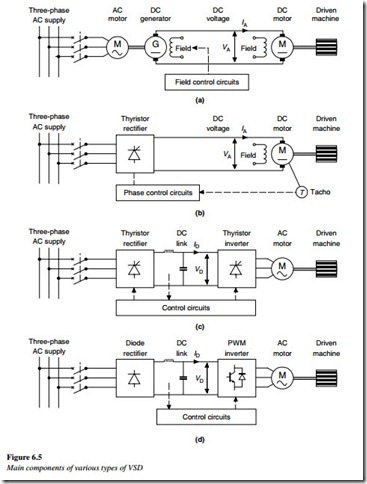Electrical VSDs
DC motors dominate in VSD applications due to their reliability. They also help to create a cheaper converter and control circuit.
As we have seen earlier, AC induction motors are mainly constant-speed motors. Since the 1980s, the popularity of the AC VSDs has grown rapidly, mainly due to advances in power electronics and digital control technology, affecting both the cost and the performance of this type of VSD. The main attraction of the AC VSDs is the rugged reliability and the low cost of the squirrel-cage AC induction motor compared to the DC motor.
As shown in Figure 6.5, changes in drives employed with respect to time have been shown. Figure 6.5 sections (a), (b), (c), and (d) are as per the following:
(a) Ward-Leonard system
(b) Thyristor-controlled DC drive
(c) Voltage source inverter (PAM) AC drive
(d) PWM voltage source (PWM) AC drive.
The development path from the Ward-Leonard system to the thyristor-controlled DC drive and then to the PWM-type AC variable voltage, variable frequency converter is illustrated in Figure 6.5. In the first step, from (a) to (b), the high-cost motor-generator set has been replaced with a phase-controlled thyristor rectifier. In the second step, from (b) to (d), the high-cost DC motor has been replaced with a power electronic PWM inverter and a simple rugged AC induction motor. In an AC VSD, the mechanical commutation system of the DC motor has been replaced by a power electronic circuit called the inverter. However, the main difficulty with the AC VSD has always been the complexity, cost, and reliability of the AC frequency inverter circuit.
AC motor speed control
Developments in power electronics over the last 10–15 years has made it possible to control not only the speed of the AC induction motors but also the torque. Modern AC- VSDs, with flux-vector control, can now meet all the performance requirements of even the most demanding applications.
The methods of speed control are listed below:
1. Stator voltage control
2. Supply frequency control
3. Rotor resistance control
4. Pole changing.
Usually, the AC motor speed control is achieved by varying its supply frequency. In order to keep the losses minimum, the terminal voltage frequency is changed to keep the v/f ratio constant. The frequency control method of changing the speed of AC motors is a well-known technique for decades. Only recently, however, it has become a technically viable and economical method of VSD control.
AC drives have become a more cost-effective method of speed control, in comparison to DC drives, for most VSD applications of up to 1000 kW. It is also the technically preferred solution, for many industrial environments, where the reliability and the low maintenance, associated with the AC squirrel-cage induction motor are important.
The mains AC supply voltage is converted into a DC voltage and current through a rectifier. The DC voltage and current are filtered to smooth out the peaks before being fed into an inverter, where they are converted into a variable AC voltage and frequency. The output voltage is controlled, so that the ratio between the voltage and frequency remains constant in order to avoid over-fluxing the motor. The AC motor is able to provide its rated torque over the speed range of up to 50 Hz, without a significant increase in losses.
The motor can be run at speeds above the rated frequency, but with a reduced output torque. The torque is reduced because of the reduction in the air-gap flux, which depends on the V/f ratio. At frequencies below 50 Hz, a constant torque output from the motor is possible. At frequencies above the base frequency of 50 Hz, the torque is reduced in proportion to the reduction in speed.
One of the main advantages of VVVF (variable voltage variable frequency) speed control system is that, while the controls are necessarily complex, the motors themselves can be of a squirrel-cage construction, which is probably the most robust, and maintenance-free form of electric motor yet devised. This is particularly useful where the motors are mounted in hazardous locations, or in inaccessible positions, making routine cleaning and maintenance difficult. In locations that require machines to have flameproof or even waterproof enclosures, a squirrel-cage AC induction motor would be cheaper than a DC motor.
On the other hand, an additional problem with the standard AC squirrel-cage motors when used for variable speed applications is that they are cooled by means of a shaft- mounted fan. At low speeds, cooling is reduced, which affects the load ability of the drive. The continuous output torque of the drive must be de-rated for lower speeds, unless a separately powered auxiliary fan is used to cool the motor. This is similar to the cooling requirements of DC motors, which require a separately powered auxiliary cooling fan.
DC motor speed control
DC drives are widely used in the industry for their variable speed, good speed regulation, braking, and reversing ability.
In the past, DC motors were used in most of the VSD applications in spite of the complexity, high cost, and high maintenance requirements of the DC motors.
Even today, DC drives are still often used for the more demanding VSD applications.
Examples of this are the sectional drives for paper machines, which require a fast dynamic response and a separate control of speed and torque.
Methods of speed control are given below
1. Armature voltage control
2. Field flux control.
Most of the DC drives employ armature voltage control method and field flux control, in order to achieve speed regulation, both below the rated speed and above the rated speed respectively. In both cases, the half- and fully controlled rectifier or converter is used to achieve a variable DC voltage, from AC voltage, to supply to the armature voltage.
Both the AC and DC drives use a converter or rectifier and inverter usually. The following section details such devices.
